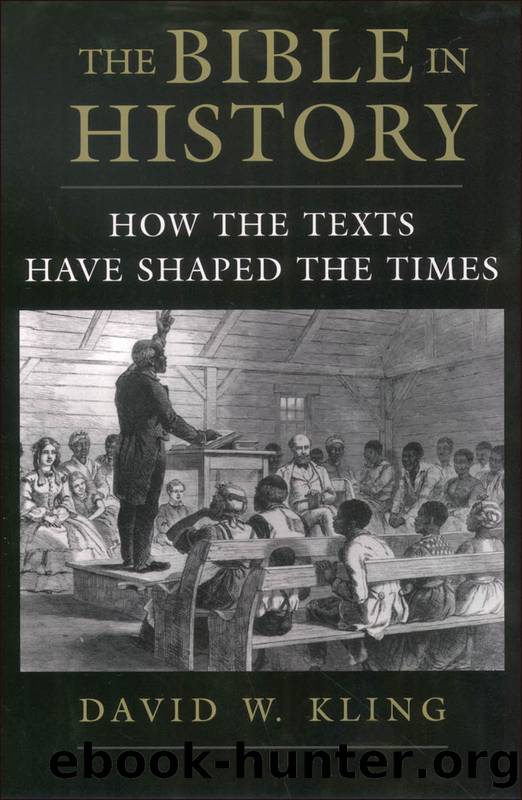The Bible in History by Kling David W.; Kling David W.;

Author:Kling, David W.; Kling, David W.;
Language: eng
Format: epub
Publisher: Oxford University Press USA - OSO
Published: 2004-02-14T16:00:00+00:00
6
âLet My People Goâ
Exodus in the African American Experience
The Egyptians became ruthless in imposing tasks on the Israelites, and made their lives bitter with hard service in mortar and brick and in every kind of field labor.⦠Then the LORD said, âI have observed the misery of my people who are in Egypt; I have heard their cry on account of their taskmasters. Indeed, I know their sufferings, and I have come down to deliver them from the Egyptians.â¦â Then the LORD said to Moses, âGo to Pharaoh and say to him, âThus says the LORD: Let my people go, so that they may worship me.ââ
âExodus 1:13â14; 3: 7â8; 8:1
For nearly ten years, until my early teens, our family would make an annual summer vacation trip from the upper Midwest to visit my grandparents and other relatives in Hope, Arkansas. This was not merely a trip to another part of the country; it was a trip to another world. People sounded different, the air smelled different, the scenery looked different. As we drove on two-lane highways deeper and deeper into the South, signs of poverty became increasingly apparent. Ramshackle homes, inhabited by poor whites and impoverished blacks, and discarded, rusted-out farm equipment frequented the rural landscape. Arriving in Hope amid suffocating heat and humidity, we entered a world of southern mores, one defined by gracious hospitality and racial segregation. My uncle called us âYankees.â I never knew exactly what he meant by the term, but I did know that it set us northerners apart from our southern kin, and I knew it had something to do with a bygone war.
Hope typified the rural Deep South of the 1950s and early 1960s. Signs posted in entrances to public places such as rest rooms, restaurants, and parks, announced âColoredâ or âWhites Only.â My relatives, lawabiding citizens and devout Christians, embraced this southern way of life as normal. The message was clear: whites ruled. They controlled the political and economic bases of power and kept blacks âin their placeâ by overt and covert means, ranging from denying blacks equal educational opportunities and public facilities to occasional night visitations by the Ku Klux Klan. From what I witnessed, blacks apparently accepted their lot and observed the customs of southern life without complaint. I was unaware of any dissatisfaction or civil unrest among Hopeâs African American community and certainly not among those with whom I had personal contactâthe black women who provided daily domestic help for my apparently wealthy relatives.
I eventually learned that my childhood perceptions were skewed and tinged with racism. Hopeâs black population lived with little or no hope of ever escaping grinding poverty or oppressive racism. They knew firsthand what it meant to be second-class citizens in a land dedicated ostensibly to freedom for all people. Two now famous African Americans who grew up not far from Hope opened my eyes to a world of rural southern blacks far removed from my naïve childhood perceptions. Twenty miles south of Hope is Stamps, the childhood home of the prize-winning poet and novelist Maya Angelou.
Download
This site does not store any files on its server. We only index and link to content provided by other sites. Please contact the content providers to delete copyright contents if any and email us, we'll remove relevant links or contents immediately.
The Lost Art of Listening by Michael P. Nichols(7170)
Why I Am Not A Calvinist by Dr. Peter S. Ruckman(4051)
The Rosicrucians by Christopher McIntosh(3375)
Wicca: a guide for the solitary practitioner by Scott Cunningham(3046)
Signature in the Cell: DNA and the Evidence for Intelligent Design by Stephen C. Meyer(2880)
Real Sex by Lauren F. Winner(2875)
The Holy Spirit by Billy Graham(2783)
To Light a Sacred Flame by Silver RavenWolf(2681)
The End of Faith by Sam Harris(2637)
The Gnostic Gospels by Pagels Elaine(2403)
Waking Up by Sam Harris(2334)
Nine Parts of Desire by Geraldine Brooks(2283)
Jesus by Paul Johnson(2232)
Devil, The by Almond Philip C(2207)
The God delusion by Richard Dawkins(2193)
Heavens on Earth by Michael Shermer(2191)
Kundalini by Gopi Krishna(2094)
Chosen by God by R. C. Sproul(2058)
The Nature of Consciousness by Rupert Spira(1983)
